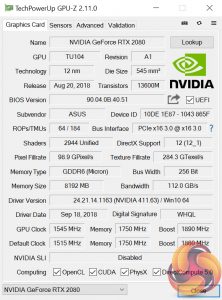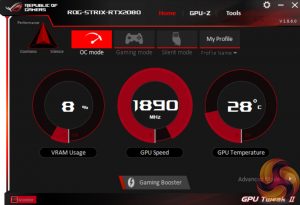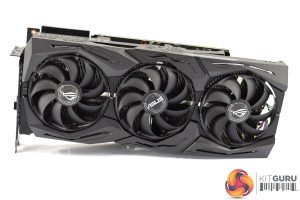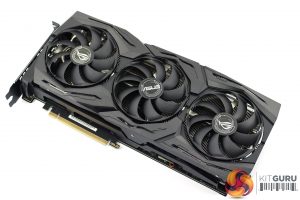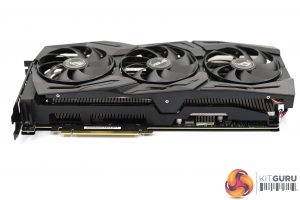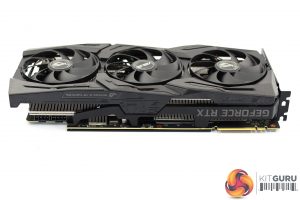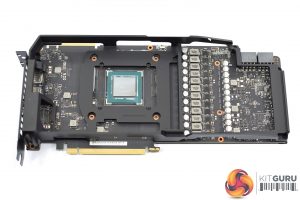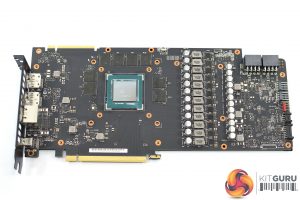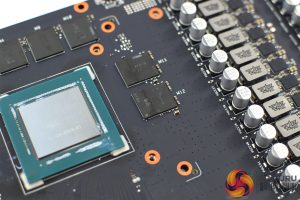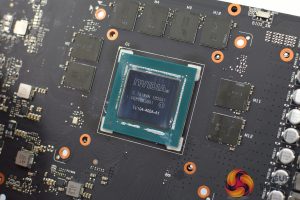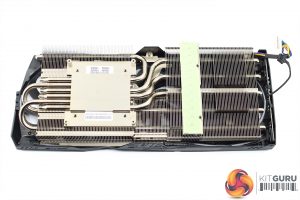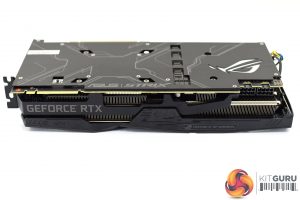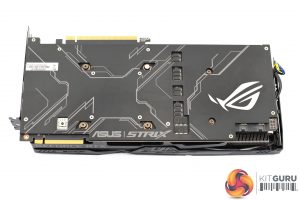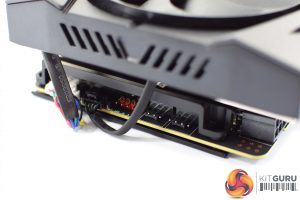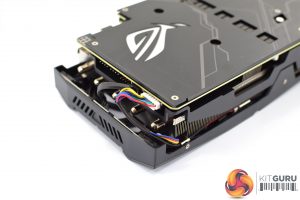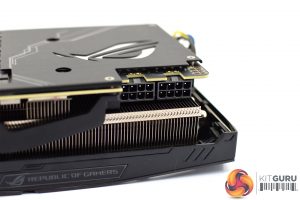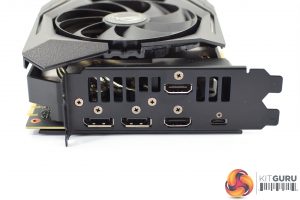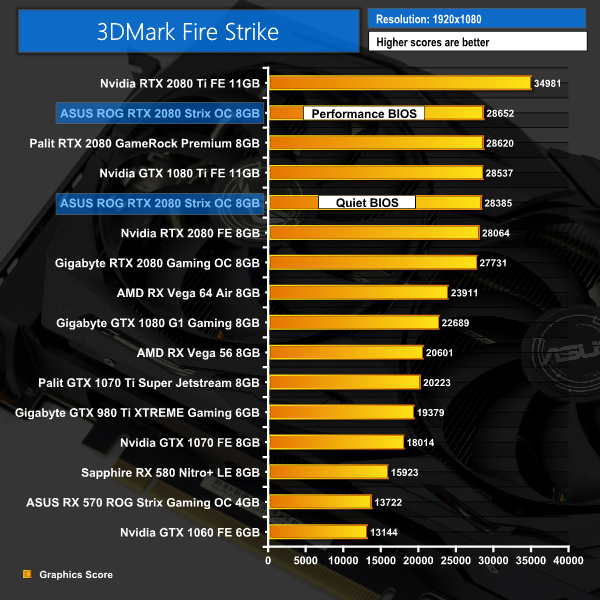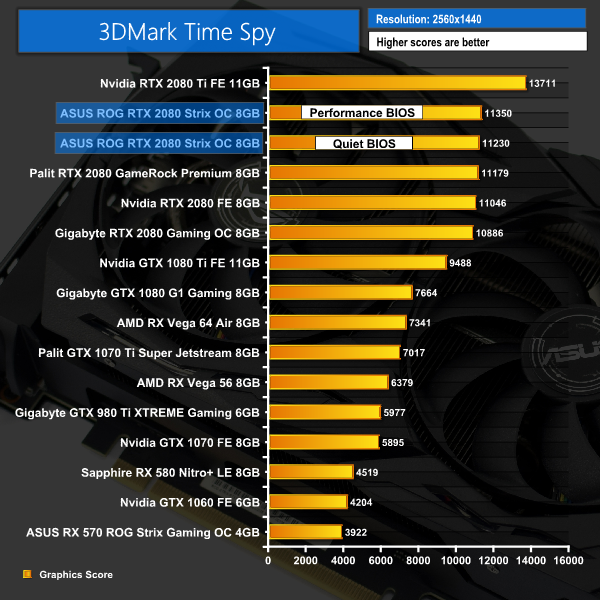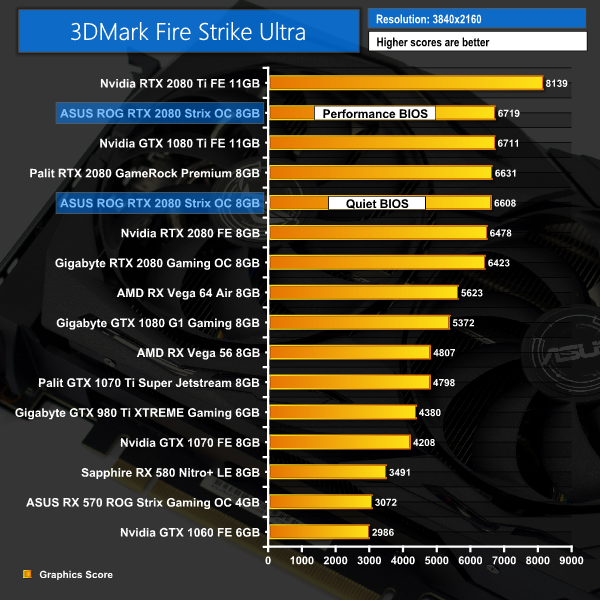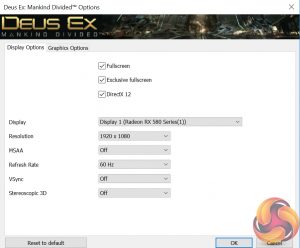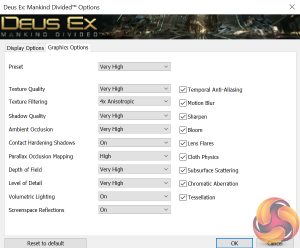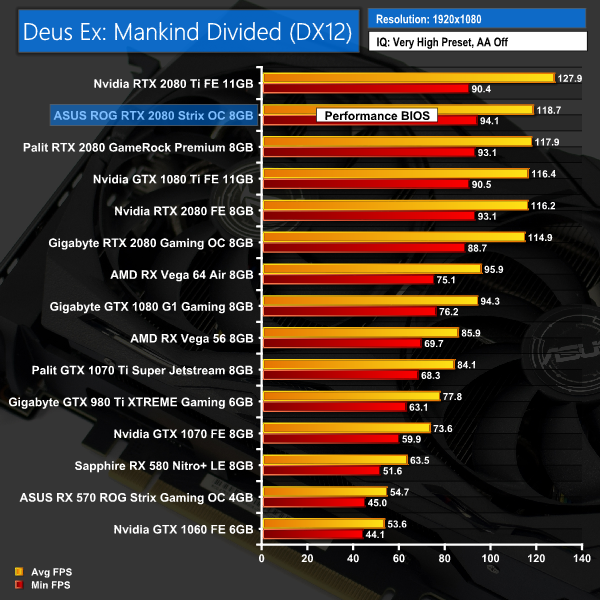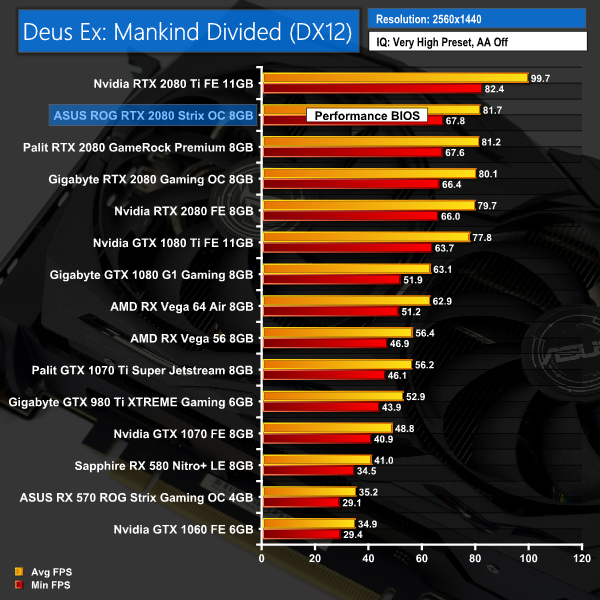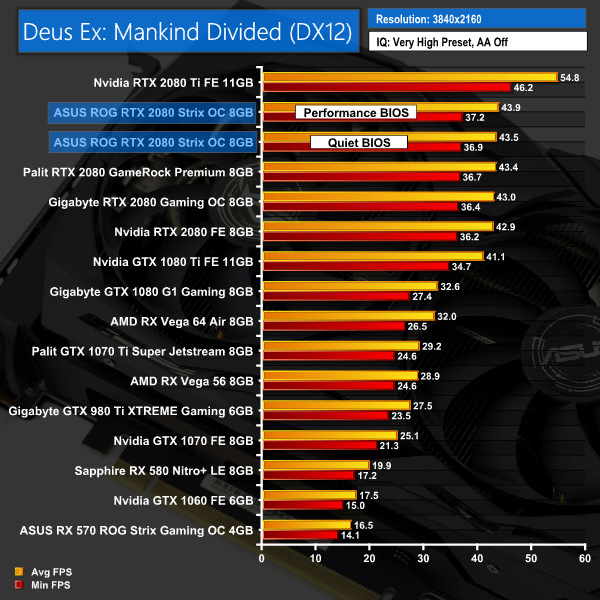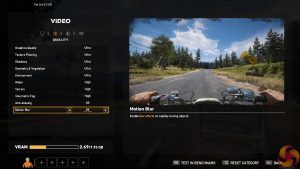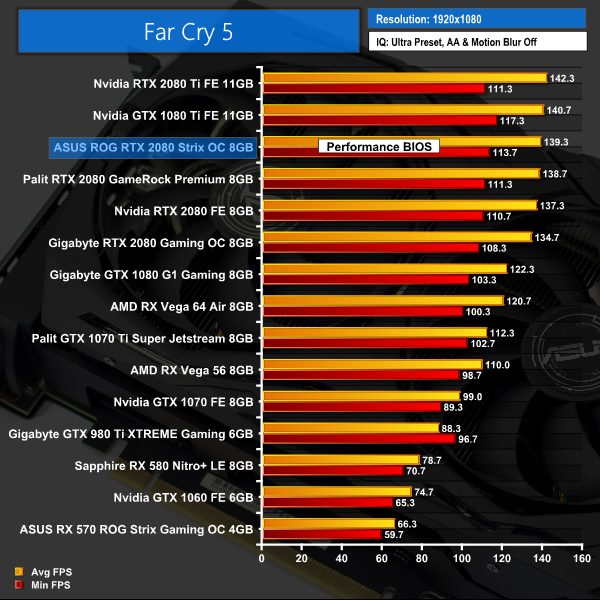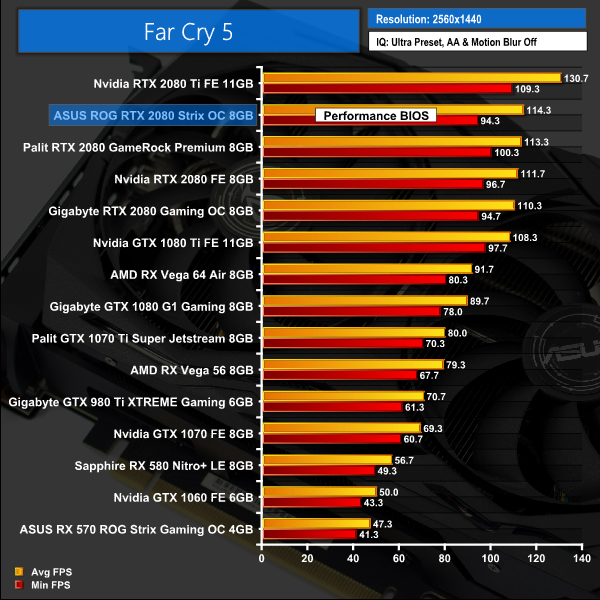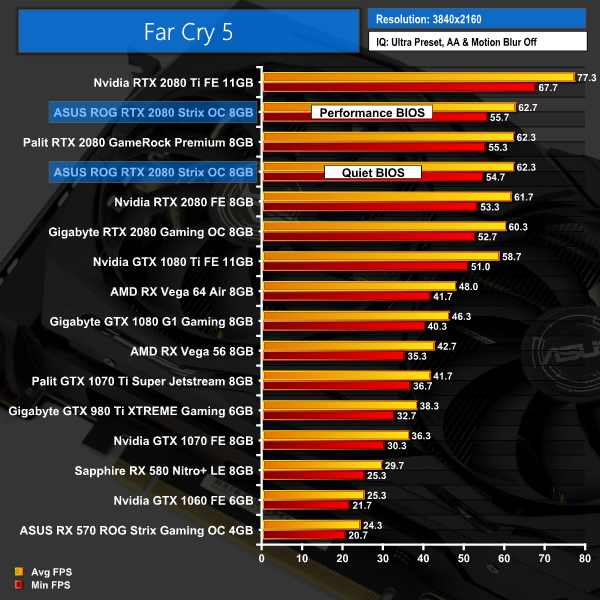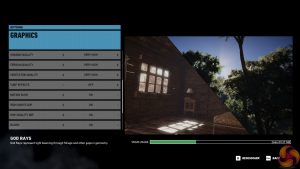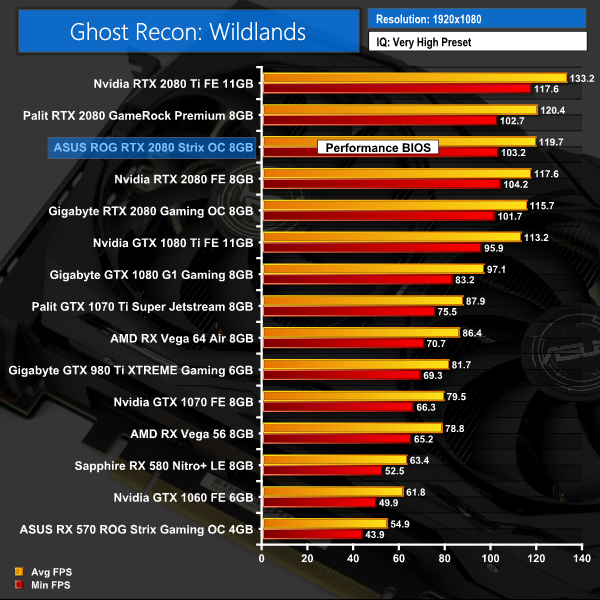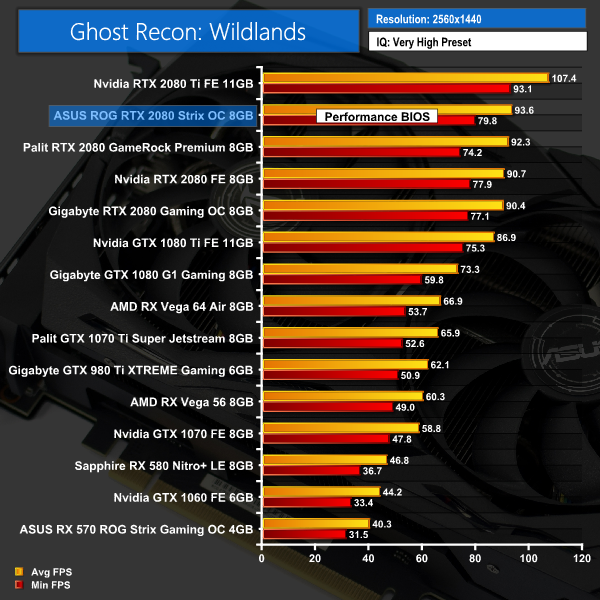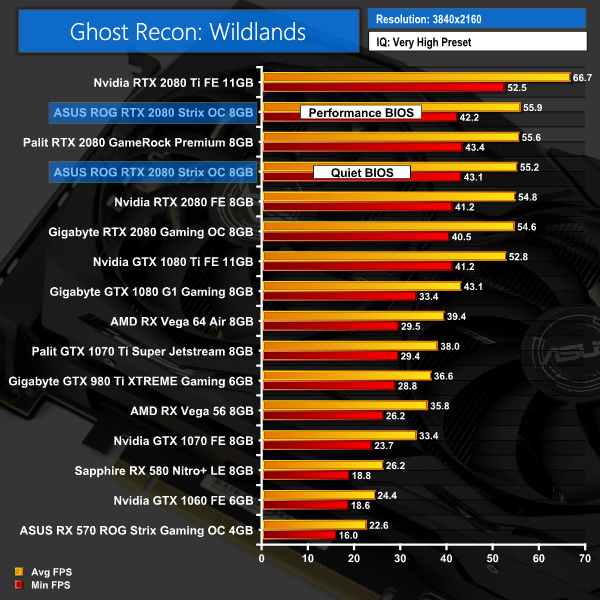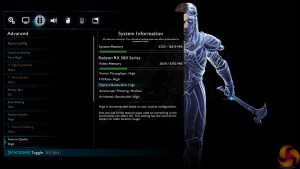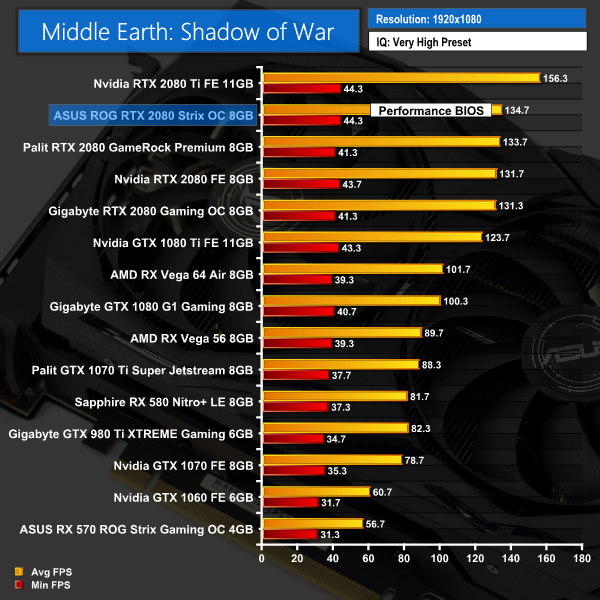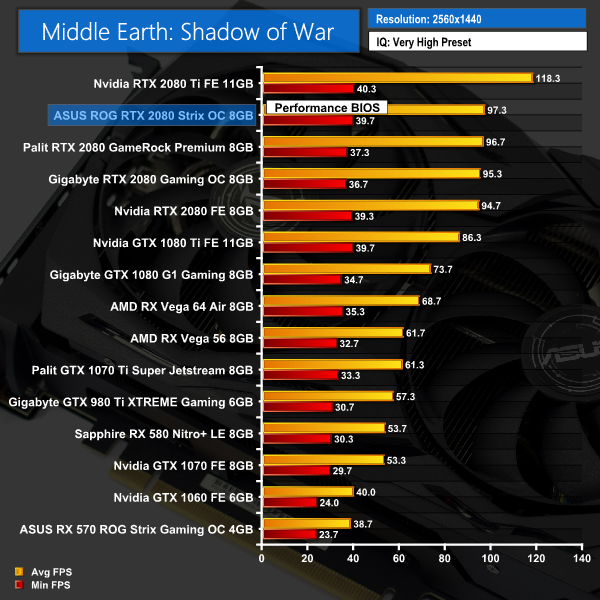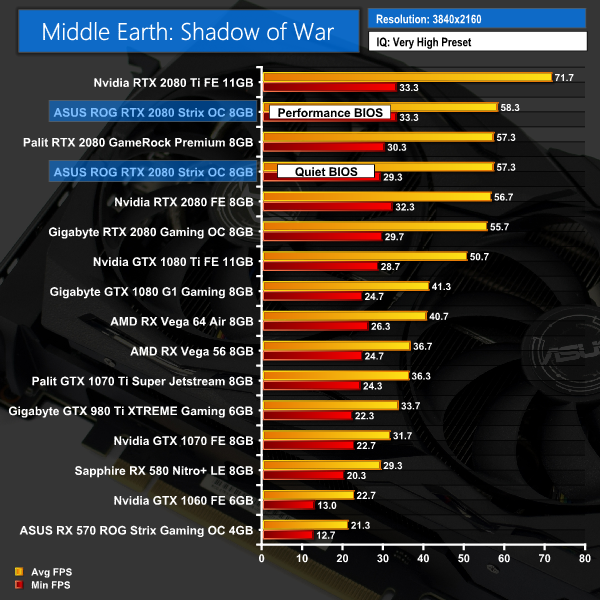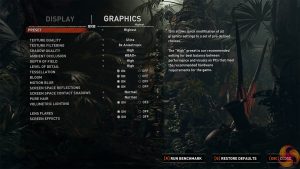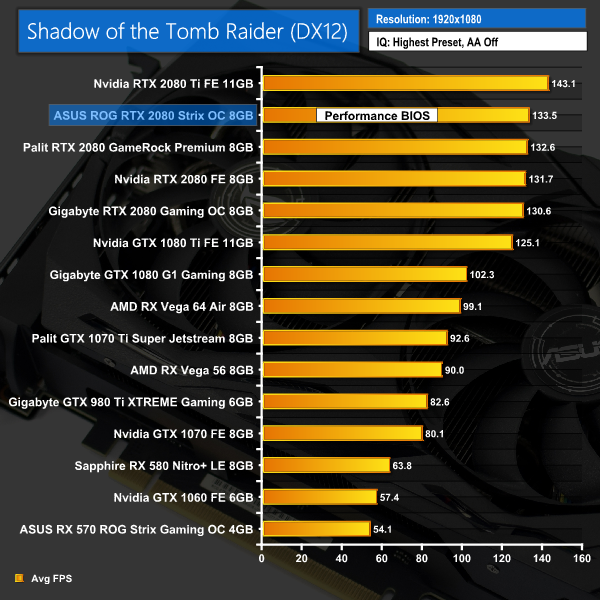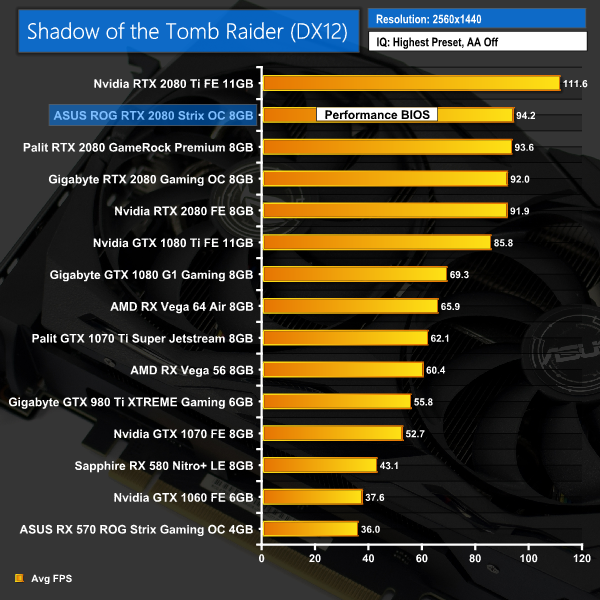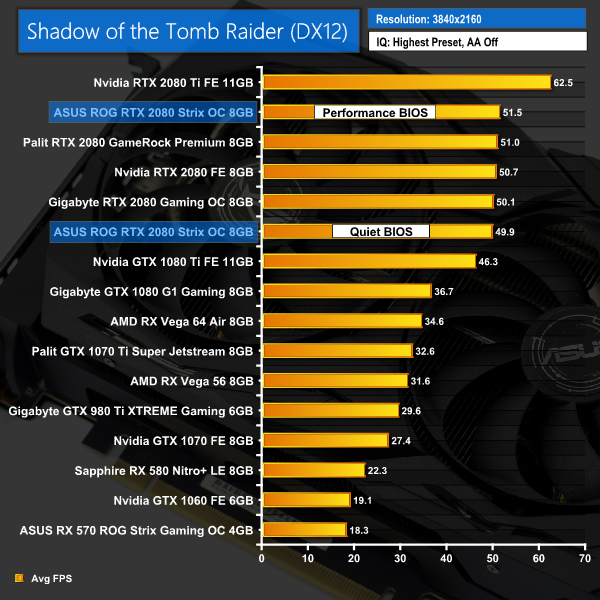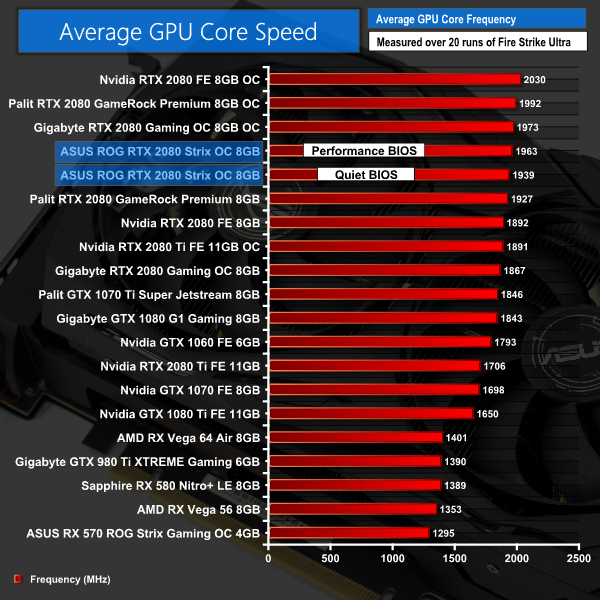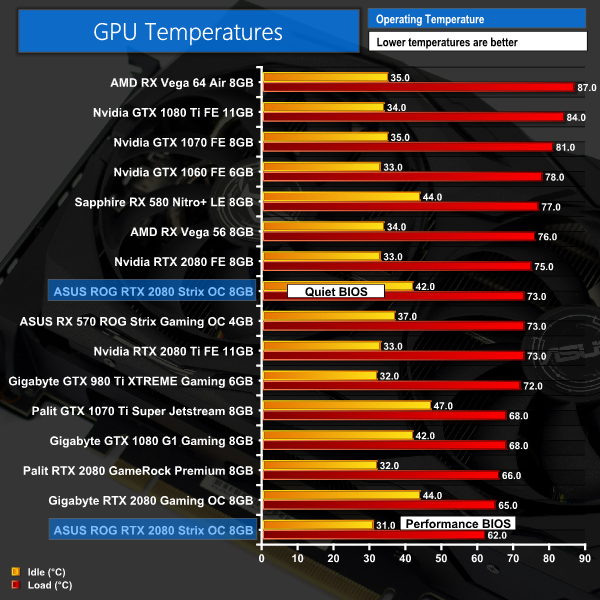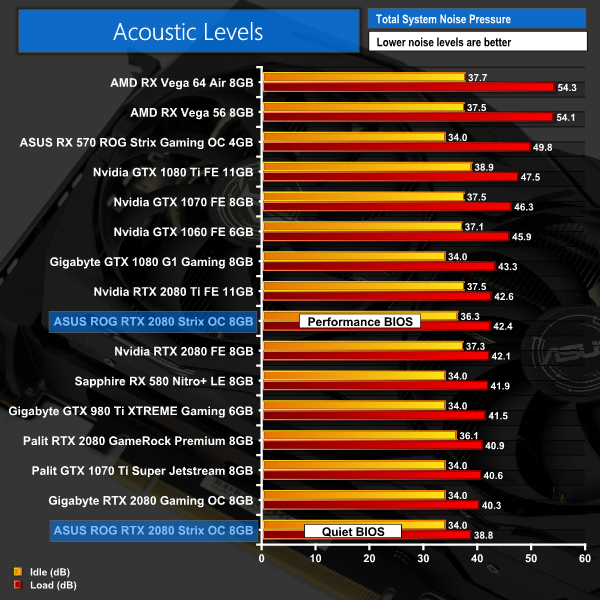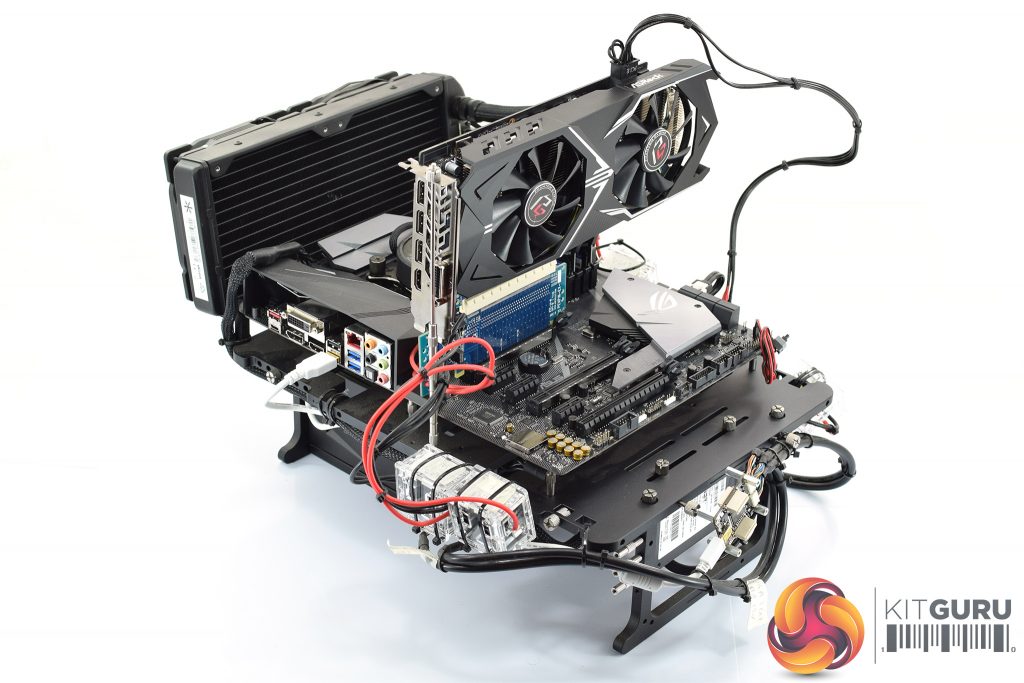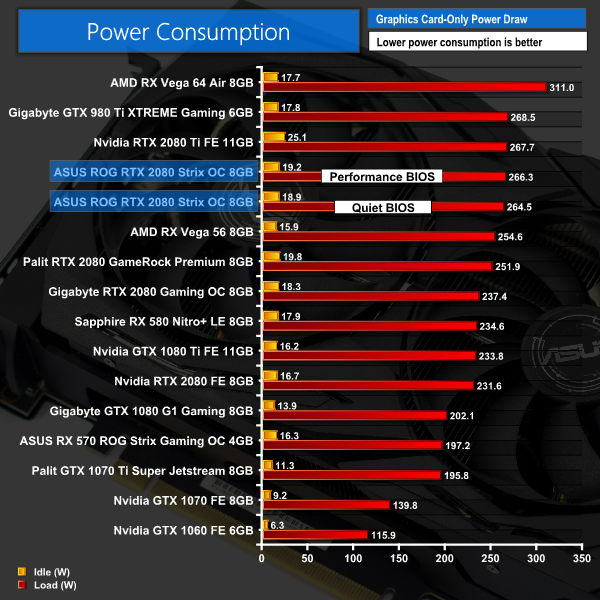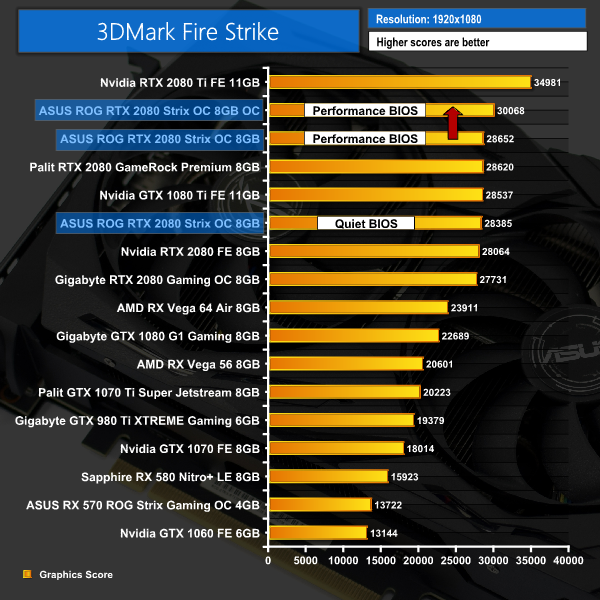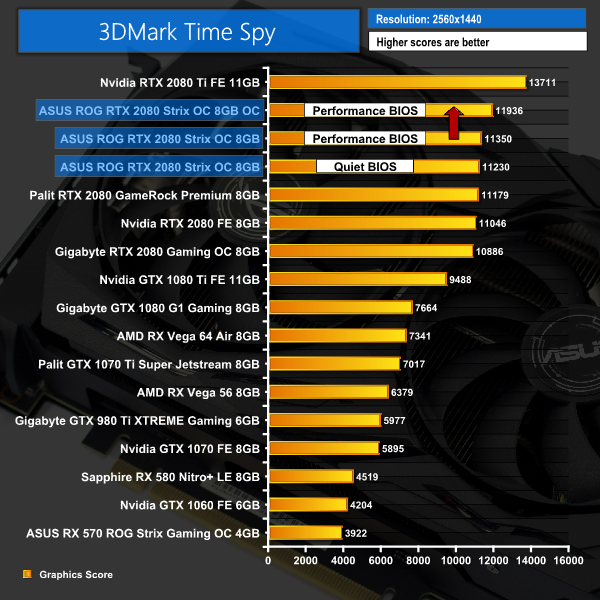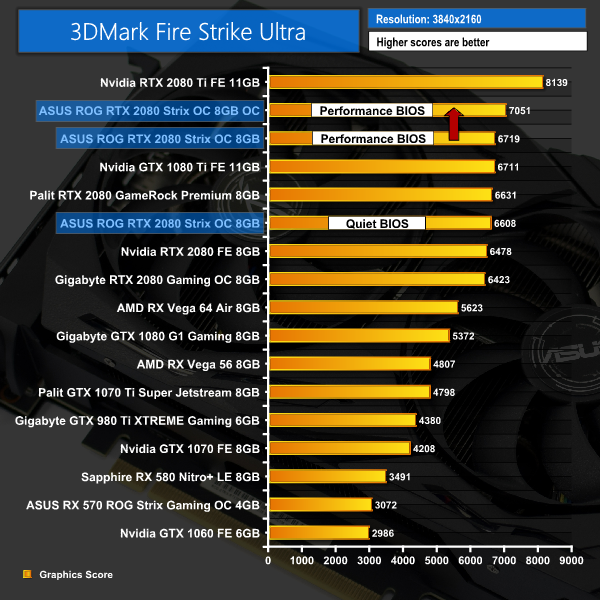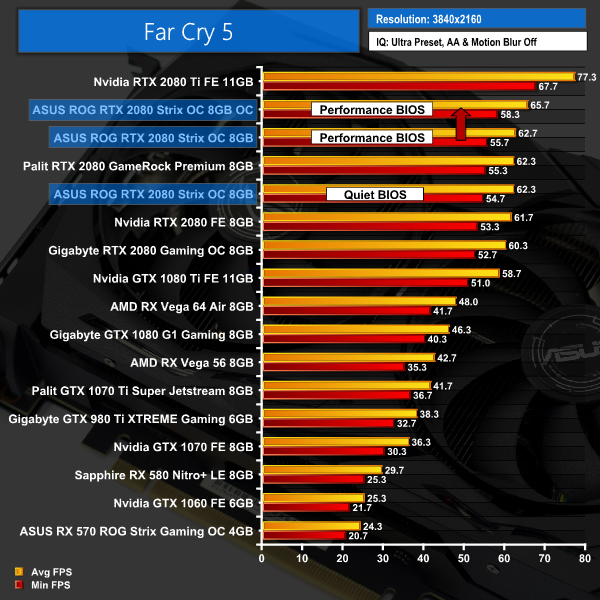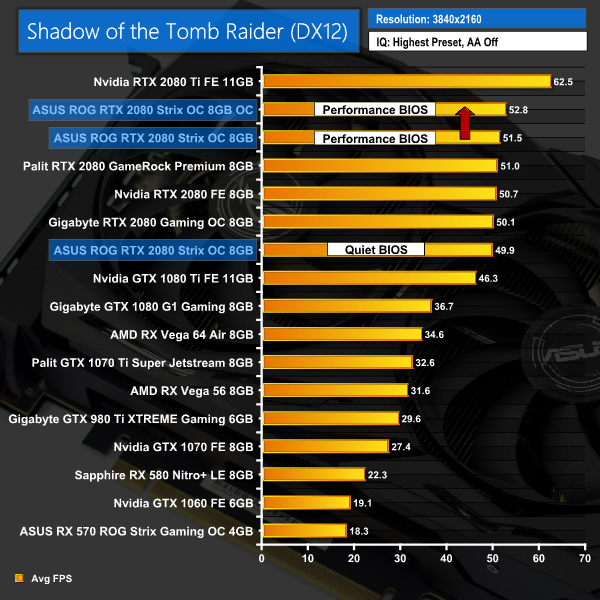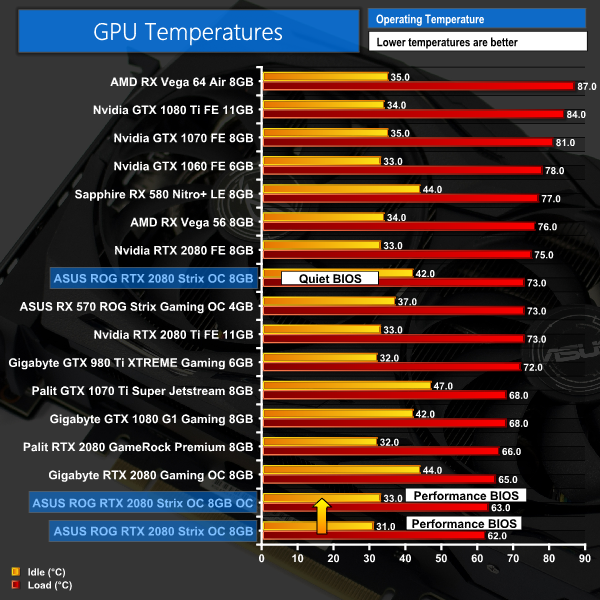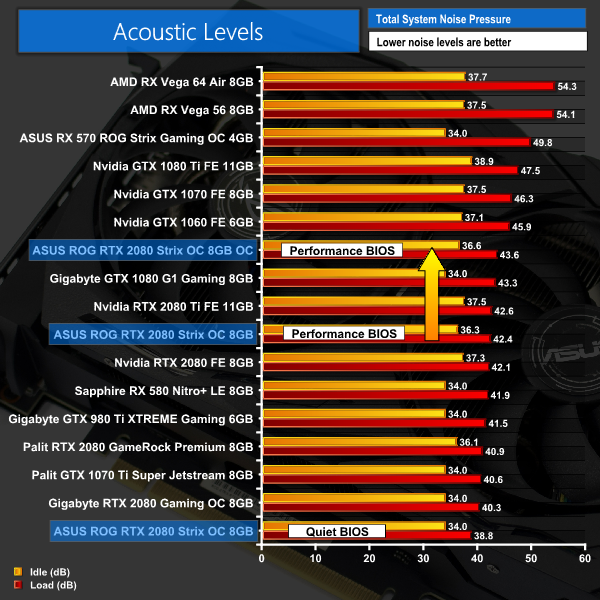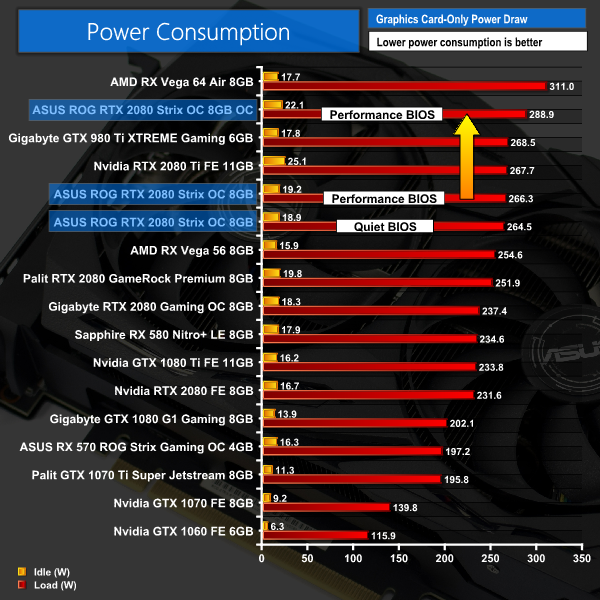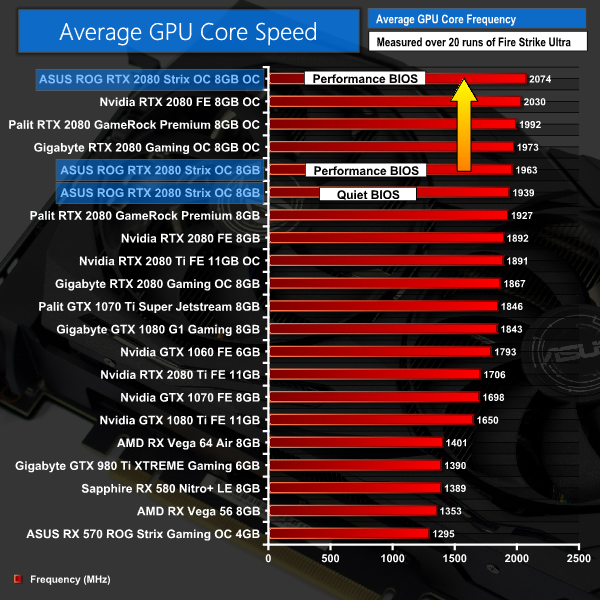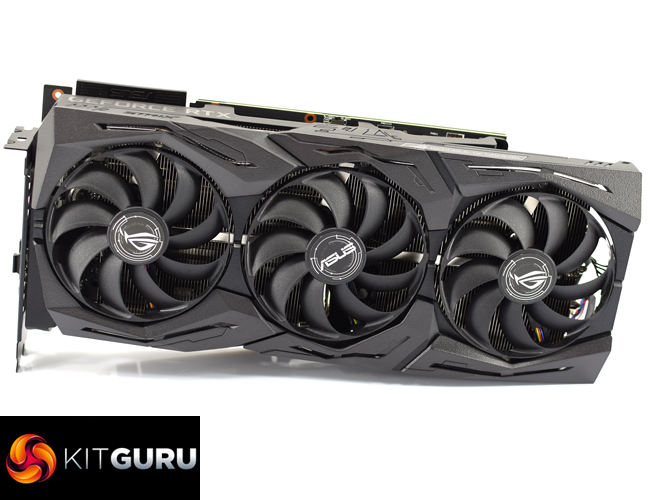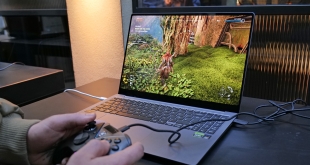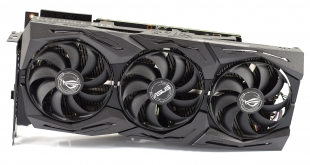
Having already analysed RTX 2080 cards from Palit and Gigabyte, today our attention turns to ASUS ROG and its RTX 2080 Strix OC (08G). This card is nothing short of a monster – in terms of its size, feature-set and its price. That's because, at £999, this is the most expensive RTX 2080 currently on the market. Could it be worth an extra £250 over Nvidia's Founders Edition? Let's find out.
With a whole raft of features – including dual-BIOS functionality, an on-card Aura RGB header and two 4-pin fan headers as well – the ASUS ROG RTX 2080 Strix OC (08G) has a lot going for it. On top of that, the fans have been redesigned, the power delivery has been improved compared to Nvidia's reference design, and ASUS even claims its heatsink has 20% more surface area than its previous generation of cards.
It certainly sounds good on paper, but most importantly – how does it perform? That what we will be testing today.
| GPU | RTX 2080 Ti (FE) | GTX 1080 Ti (FE) | RTX 2080 (FE) | GTX 1080 (FE) |
| SMs | 68 | 28 | 46 | 20 |
| CUDA Cores | 4352 | 3584 | 2944 | 2560 |
| Tensor Cores | 544 | N/A | 368 | N/A |
| Tensor FLOPS | 114 | N/A | 85 | N/A |
| RT Cores | 68 | N/A | 46 | N/A |
| Texture Units | 272 | 224 | 184 | 160 |
| ROPs | 88 | 88 | 64 | 64 |
| Rays Cast | 10 Giga Rays/sec | 1.1 Giga Rays/sec | 8 Giga Rays/sec | 0.877 Giga Rays/sec |
| RTX Performance | 87 Trillion RTX-OPS | 11.3 Trillion RTX-OPS | 60 Trillion RTX-OPS | 8.9 Trillion RTX-OPS |
| GPU Boost Clock | 1635 MHz | 1582 MHz | 1800 MHz | 1733 MHz |
| Memory Clock | 7000 MHz | 5505 MHz | 7000 MHz | 5005 MHz |
| Total Video Memory | 11GB GDDR6 | 11GB GDDR5X | 8GB GDDR6 | 8GB GDDR5X |
| Memory Interface | 352-bit | 352-bit | 256-bit | 256-bit |
| Memory Bandwidth | 616 GB/sec | 484 GB/sec | 448 GB/sec | 320 GB/sec |
| TDP | 260W | 250W | 225W | 180W |
While a Founders Edition RTX 2080 ships with a rated boost clock of 1800MHz, out of the box the ROG Strix 2080 operates at 1860MHz. This is fast, certainly, but the Palit RTX 2080 GameRock Premium we reviewed operates at 1875MHz – so it is not quite the fastest boost clock we have seen.
You can, however, download GPU Tweak II – ASUS' GPU utility tool – and enable ‘OC mode' which works as a one-click overclock to run the Strix card at 1890MHz. This is how we did our testing, to get the most from the card.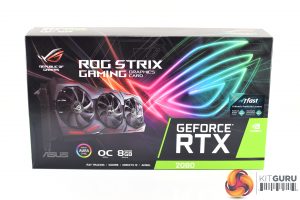
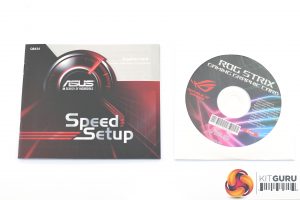
The ASUS ROG RTX 2080 Strix OC ships in a black box with a large multi-colour ROG logo dominating the front. An image of the graphics card itself occupies the left-hand side of the box.
Inside, included accessories are scarce – we find one quick start guide and one driver disk and that is it.
Moving onto the card itself, there's no denying the overall look is very similar to the previous generation of ROG Strix cards – the shroud is a very stealthy matte-black, while the three fans span the length of the card. The overall RGB implementation is also the same, with the shroud being home to twelve small LED strips which are user-configurable using ASUS Aura.
The fans have been re-designed, however – ASUS calls them ‘Axial-tech Fans' when the previous generation used the ‘Wing-blade Fans'. These new fans measure 85mm – the same as the wing-blade fans – but you will note the blade design is different, as the new fan blades are more swept in their shape, when the previous fans were much straighter.
On top of that, the ‘axial-tech fans' also have a ring around the outside of the fan blades, where the previous generation blades were left open. ASUS says this new design allows for up to 27% increased air flow, and 40% greater static pressure.
As you can probably tell, the Strix is no small piece of kit either. It measures in at 29.97 x 13.04 x 5.41cm, so even users with an ATX desktop will want to check this card will fit. Its thickness of 5.41cm makes it a 2.7 slot card.
To open the card, only six screws need to be removed. Removing the heatsink is only half the battle, though, as we can see there is a metal frame which is screwed into the backplate. This both provides extra support to the card – making it more rigid and less likely to sag – while it also acts as a heatsink for the VRAM chips. Removing this plate requires several more screws to be removed, including two from the I/O bracket.
Once that is removed, we get a clear look at the PCB. This is a custom job from ASUS with an improved 10+2 Super Alloy Power (SAP) II phase design, while ASUS claims its SAP II capacitors offer over 90,000 hours longer lifespan than traditional capacitors – though that obviously goes well beyond the scope of this review!
The 8GB of GDDR6 memory comes courtesy of Micron, with the chips labelled 8PA77D9WCW. The TU104 GPU is also labelled ‘400A' – with the A meaning this is a binned chip that Nvidia has allowed partners to sell with a factory overclock.
Another thing worth noting is the BIOS switch at the top of the PCB. This lets users choose between the ‘performance' BIOS or the ‘quiet' BIOS – the only change is the fan curve is drastically reduced when using the card with its quiet BIOS. This is something we test later in the review.
The heatsink itself makes use of 6 nickel-plated heatpipes which draw heat away into a fin array that ASUS says has 20% larger surface area than the previous generation of Strix cards. This helps explain why this Strix RTX 2080 is a 2.7 slot card, when the Strix GTX 1080 Ti was ‘only' a 2.5 slot card.
The GPU contacts with a nickel-plated copper base, and this uses ASUS' MaxContact technology which essentially makes the surface a lot flatter than traditional heat spreaders – up to 10 times flatter according to ASUS. This simply ensures increased contact between the GPU die and the plate, thus enabling greater heat transfer.
Moving onto the front side of the card, this is home to some subtle GeForce RTX branding, as well as the Republic of Gamers logo on the bottom edge. This is another of the RGB lighting zones.
The brushed metal backplate is very easy on the eye, with some white lines to add a bit of interest. The ROG eye logo on the right-hand side of the card is again illuminated by RGB LEDs.
You will also notice a small button sticking out of the backplate, just above the NVLink connector. This is actually an RGB lighting power button – you can press it to turn the lighting on or off. This will appeal to those who aren't keen on the RGB trend which has taken over almost every area of the PC building world – though I do wonder how practical this is considering you would presumably have to remove your case's side panel to push the button.
At the end of the card, we find three 4-pin headers. Two are for connecting case fans to the graphics card – this means the fan curve is controlled by the graphics card's temperature, rather than your CPU temperature which is usually much cooler when playing games. We've seen this feature before but it is certainly useful.
The other header (on the far left, with the red plastic frame) is an ASUS Aura RGB header which means you can connect various compatible RGB paraphernalia to the graphics card and control the lighting for both using the Aura software. This makes it easy to add an extra RGB LED strip (or similar) as you don't need a secondary controller to use it.
Next to these headers we find the small connector for the graphics card's own fans. I do have to call ASUS out for this, as it is a horrible multi-colour cable that has not been sleeved. It is a minor point, for sure, but when you are paying £999 for a graphics card it is certainly not too much to ask that the cables should be black rubber at the very least. This just looks lazy on ASUS' part, particularly as the connector is exposed at the end of the card, so you will be able to see it once the card is installed in your case.
Moving on, the Strix RTX 2080 requires 2x 8-pin PCIe power connectors, up from the 1x 8-pin and 1x 6-pin requirement of the Founders Edition.
Display outputs have also been tweaked, with ASUS providing 2x HDMI 2.0b ports, with 2x DisplayPort 1.4 and the USB-C connectors.Our newest GPU test procedure has been built with the intention of benchmarking high-end graphics cards. We test at 1920×1080 (1080p), 2560×1440 (1440p), and 3840×2160 (4K UHD) resolutions.
We try to test using the DX12 API if titles offer support. This gives us an interpretation into the graphics card performance hierarchy in the present time and the near future, when DX12 becomes more prevalent. After all, graphics cards of this expense may stay in a gamer’s system for a number of product generations/years before being upgraded.
We tested the RX Vega64 and Vega56 using the ‘Turbo‘ power mode in AMD’s WattMan software. This prioritises all-out performance over power efficiency, noise output, and lower thermals
As mentioned, the Strix runs at 1860MHz out of the box, but we tested using the OC mode within GPU Tweak II to raise the boost clock an extra 30MHz.
We did the bulk of our testing using the card's performance BIOS to get the most from the card. We did re-run some tests using the quiet BIOS – including all of our 4K gaming benchmarks – to see what performance difference it made. Each result for the card is clearly marked depending on what BIOS was used.
It is also worth clarifying that clock speed is not affected by choice of BIOS – so we used both with the 1890MHz OC mode enabled. However, we can expect a significantly quieter fan curve to cause the GPU to run hotter, thus affecting how far GPU Boost 4.0 will take the clock speed. How much of a difference that will make (if any) is what we are testing today.
Driver Notes
- AMD graphics cards were benchmarked with the Adrenalin 18.9.1 driver.
- Nvidia graphics cards (apart from RTX 20 series cards) were benchmarked with the Nvidia 399.24 driver.
- RTX 20 series cards were benchmarked with the Nvidia 411.63 driver.
Test System
We test using the Overclockers UK Germanium pre-built system. You can read more about it over HERE. It is important to note we have had to re-house the components to an open-air test bench to accommodate our new GPU power testing (more on that later) but the core of the system is unchanged and the performance figures you see presented here are what you can expect from the Germanium.
| CPU |
Intel Core i7-8700K
Overclocked to 4.8GHz |
| Motherboard |
ASUS ROG Strix Z370-F Gaming
|
| Memory |
Team Group Dark Hawk RGB
16GB (2x8GB) @ 3200MHz 16-18-18-38 |
| Graphics Card |
Varies
|
| System Drive |
Patriot Wildfire 240GB
|
| Games Drive | Crucial M4 512GB |
| Chassis | Streacom ST-BC1 Bench |
| CPU Cooler |
OCUK TechLabs 240mm AIO
|
| Power Supply |
SuperFlower Leadex II 850W 80Plus Gold
|
| Operating System |
Windows 10 Professional
|
Comparison Graphics Cards List
- Nvidia RTX 2080 Ti Founders Edition (FE) 11GB
- Nvidia RTX 2080 Founders Edition (FE) 8GB
- Gigabyte RTX 2080 Gaming OC 8GB
- Palit RTX 2080 GameRock Premium 8GB
- Nvidia GTX 1080 Ti Founders Edition (FE) 11GB
- Gigabyte GTX 1080 G1 Gaming 8GB
- Palit GTX 1070 Ti Super Jetstream 8GB
- Nvidia GTX 1070 Founders Edition (FE) 8GB
- Nvidia GTX 1060 Founders Edition (FE) 6GB
- Gigabyte GTX 980 Ti XTREME Gaming 6GB
- AMD RX Vega 64 Air 8GB
- AMD RX Vega 56 8GB
- Sapphire RX 580 Nitro+ Limited Edition (LE) 8GB
- ASUS RX 570 ROG Strix Gaming OC 4GB
Software and Games List
- 3DMark Fire Strike & Fire Strike Ultra (DX11 Synthetic)
- 3DMark Time Spy (DX12 Synthetic)
- Deus Ex: Mankind Divided (DX12)
- Far Cry 5 (DX11)
- Tom Clancy’s Ghost Recon: Wildlands (DX11)
- Middle Earth: Shadow of War (DX11)
- Shadow of the Tomb Raider (DX12)
We run each benchmark/game three times, and present averages in our graphs.3DMark Fire Strike is a showcase DirectX 11 benchmark designed for today’s high-performance gaming PCs. It is our [FutureMark’s] most ambitious and technical benchmark ever, featuring real-time graphics rendered with detail and complexity far beyond what is found in other benchmarks and games today.
Performance BIOS:
Quiet BIOS:
It's a very positive first start for the ASUS ROG RTX 2080 Strix OC. It gives the highest scores we have seen from an RTX 2080 so far when using the performance BIOS, while the quiet BIOS is still very competitive as well.Deus Ex: Mankind Divided is set in the year 2029, two years after the events of Human Revolution and the “Aug Incident”—an event in which mechanically augmented humans became uncontrollable and lethally violent. Unbeknownst to the public, the affected augmented received implanted technology designed to control them by the shadowy Illuminati, which is abused by a rogue member of the group to discredit augmentations completely. (Wikipedia).
We test using the Very High preset, with MSAA disabled. We use the DirectX 12 API.
Deus Ex: Mankind Divided follows on from 3DMark exactly – we see the Strix RTX 2080 come out faster than the Palit RTX 2080 GameRock Premium across all three resolutions. Interestingly, switching from the performance BIOS to the quiet BIOS only resulted in a loss of 0.4FPS when gaming at 4K.Far Cry 5 is an action-adventure first-person shooter game developed by Ubisoft Montreal and Ubisoft Toronto and published by Ubisoft for Microsoft Windows, PlayStation 4 and Xbox One. It is the eleventh entry and the fifth main title in the Far Cry series, and was released on March 27, 2018.
The game takes place in the fictional Hope County, Montana, where charismatic preacher Joseph Seed and his cult Project at Eden’s Gate holds a dictatorial rule over the area. The story follows an unnamed junior deputy sheriff, who becomes trapped in Hope County and works alongside factions of a resistance to liberate the county from Eden’s Gate. (Wikipedia).
We test using the Ultra preset, with AA and motion blur disabled.
The ASUS Strix once again edges ahead of the other RTX 2080 cards when we get to Far Cry 5. While it is the fastest card here, the margins are not big – there's only 2.4FPS between the top and bottom RTX 2080 cards at 4K.Tom Clancy’s Ghost Recon Wildlands is a tactical shooter video game developed by Ubisoft Paris and published by Ubisoft. It was released worldwide on March 7, 2017, for Microsoft Windows, PlayStation 4 and Xbox One, as the tenth installment in the Tom Clancy’s Ghost Recon franchise and is the first game in the Ghost Recon series to feature an open world environment. (Wikipedia).
We test using the Very High preset.
With Ghost Recon: Wildlands, it is interesting to see the Strix fall just behind the Palit GameRock Premium at 1080p – although the CPU is a fairly significant bottleneck here anyway. At 1440p and 4K, the Strix does again prove to be the faster card – but only just.
It is also worth pointing out the gap between the quiet BIOS and the performance BIOS is again very small – with just a 0.7FPS difference at 4K.Middle-earth: Shadow of War is an action role-playing video game developed by Monolith Productions and published by Warner Bros. Interactive Entertainment. It is the sequel to 2014’s Middle-earth: Shadow of Mordor, and was released worldwide for Microsoft Windows, PlayStation 4, and Xbox One on October 10, 2017. (Wikipedia).
We test using the Very High preset.
Middle Earth: Shadow of Mordor continues the trend we have seen so far – the higher boost clock takes the Strix RTX 2080 just head of the three other RTX 2080 cards we have tested. It's still only an extra 2.6FPS for the Strix when gaming at 4K, though, so the margins are not big – but it's something.Shadow of the Tomb Raider is an action-adventure video game developed by Eidos Montréal in conjunction with Crystal Dynamics and published by Square Enix. It continues the narrative from the 2013 game Tomb Raider and its sequel Rise of the Tomb Raider, and is the twelfth mainline entry in the Tomb Raider series. The game released worldwide on 14 September 2018 for Microsoft Windows, PlayStation 4 and Xbox One. (Wikipedia).
We test using the Highest preset, with AA disabled. We test using the DX12 API.
As expected, Shadow of the Tomb Raider again has the Strix as the fastest RTX 2080 card. It takes a 0.8FPS lead over the Founders Edition at 4K resolution.
The quiet BIOS is 1.6FPS slower at 4K than the performance BIOS, too – though it is essentially on par with the Gigabyte RTX 2080 Gaming OC.Here we present the average clock speed for each graphics card while running the 3DMark Fire Strike Ultra stress test 20 times. We use GPU-Z in tandem with the Powenetics Project (see the previous page) to record the GPU core frequency during the Fire Strike Ultra runs – at the end, we are left with around 4300 data entries.
We calculate the average core frequency during the entire 20-run test to present here.
Given we saw the Strix performing consistently faster than the other RTX 2080 cards, it is no surprise to see it recorded an impressively fast average clock speed of 1963MHz – 71MHz faster than the Founders Edition, and 36MHz faster than the Palit GameRock Premium.
It's also very impressive to see that using the quiet BIOS only dropped the frequency by 24MHz – we'll see the thermal and noise implications of using this BIOS over the next two pages.For our temperature testing, we measure the peak GPU core temperature under load, as well as the GPU temperature with the card idling on the desktop. A reading under load comes from running the 3DMark Fire Strike Ultra stress test 20 times. An idle reading comes after leaving the system on the Windows desktop for 30 minutes.
This is where things get very interesting. Starting with the performance BIOS, a peak of 62C on the GPU core is fantastic – it's 3C cooler than the next-best aftermarket RTX 2080, and a huge 13C cooler than the Founders Edition.
Arguably more impressive is that the quiet BIOS peaked at just 73C – still 2C cooler than Founders, and as we will see on the next page, it is very quiet indeed.
Still, moving onto the thermal gun testing, the images above show the card when running the performance BIOS. The side of the card peaked at 68C, and that was an area of the aluminium fin stack.
The rear of the card peaked at 65.4C, which is another top result – this was an area of the PCB that was left exposed. The rest of the backplate is visibly cooler on the image above. In any case, both results are excellent and are nowhere near the thermal limits of the components.We take our noise measurements with the sound meter positioned 1 foot from the graphics card. I measured the sound floor to be 34 dBA, thus anything above this level can be attributed to the graphics cards. The power supply is passive for the entire power output range we tested all graphics cards in, while all CPU and system fans were disabled.
A reading under load comes from running the 3DMark Fire Strike Ultra stress test 20 times. An idle reading comes after leaving the system on the Windows desktop for 30 minutes.
Starting with the performance BIOS result, a peak of 42.4C is certainly not loud. It is marginally louder than the Founders Edition – and thus just over 2dB louder than the Gigabyte RTX 2080 Gaming OC – but you'd still be hard-pressed to hear it once it's running in a case.
The quiet BIOS, however, is on another level – the word ‘quiet' is somewhat of an understatement! A peak of 38.8dB is really something incredible – particularly when we consider the card could still run at over 1900MHz, and the GPU temperature only peaked at 73C. To give you an idea of how quiet the Strix is in this mode, I had to put my ear right up against the shroud to hear the fans spin – and this is with the card on an open-air test bench. In a case? You simply wouldn't know it was there.
When comparing the fan speeds of each BIOS, it becomes easy to see why the quiet BIOS is so much quieter. The performance BIOS ran the fans at an average speed of 1676 rpm, whereas the quiet BIOS ran the fans at an average speed of just 1109 rpm – over 500 rpm, or 34%, slower.
We have recently revamped our GPU power consumption testing. Previously we would measure the total system power draw with each graphics card installed. Given that the rest of the components did not change, this gave us an idea of the relative power consumption of each graphics card, but we could not be more specific than that.
Now, however, thanks to Cybenetics Labs and its Powenetics Project, we are able to measure the power consumption of the graphics card alone, giving much more precise and accurate data. Essentially, this works by installing sensors in the PCIe power cables, as well as the PCIe slot itself thanks to a special riser card. This data is recorded using specialist software provided by Cybenetics Labs and given it polls multiple times a second (between 6 and 8 times a second, based on my observations) we can track the power consumption in incredible detail over any given amount of time.
You can read more about the Powenetics Project over HERE.
As with previous testing, a reading under load comes from running the 3DMark Fire Strike Ultra stress test 20 times. An idle reading comes after leaving the system on the Windows desktop for 30 minutes. This stress test (20 runs) produces approximately 4300 data entries in the Powenetics software, which we can then export to an Excel file and analyse further. Here we present the average continuous power consumption of each graphics card across the entire 20 run test.
Unsurprisingly, given its clock speed advantage over the other RTX 2080 cards, we see the Strix 2080 drawing an extra 15W or so compared to the Palit GameRock Premium – that's about 35W more than the Founders Edition. It's worth noting, but if you are spending £999 on a graphics card it is not going to bother you.
Incidentally, the quiet BIOS doesn't even draw 2W less than the performance BIOS which isn't a huge surprise given the clock speed gap between the two is just 24MHz.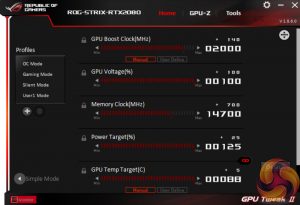
When overclocking the Strix OC, we used GPU Tweak II with the performance BIOS engaged. We maximised the the voltage, power limit and temperature target sliders before adding +140MHz to the GPU core and +700MHz to the memory. It's worth noting that the ‘+140MHz' is relative to the out of the box clock speed (1860MHz), so considering we tested the card at 1890MHz, we really added an extra +110MHz to that.
3DMark and Games Testing
This overclock netted us some decent gains – a jump past the 30,000 score mark in Fire Strike is impressive and represents a 5% increase in performance. We didn't see quite as a big an improvement in our games, with an extra 3FPS in Far Cry 5 and an extra 1.3FPS playing Shadow of the Tomb Raider.Here, we take a further look at the impact of our overclock, looking at the increased temperatures, acoustics, power draw, and lastly, the effect had on the average clock speed.
Temperatures
Acoustics
Power consumption
Average clock speed under load
Overview
Starting with thermals, it is hugely impressive to see that the Strix only got 1C hotter when overclocked. Part of this is thanks to the increased fan speed – and thus greater noise output – but considering the extra frequency gained, it's a small price to pay. Power consumption does go up another 22W, though again this is not too concerning.
The overclock also gave us an average frequency of 2074MHz, which is fantastic and puts it 44MHz faster than our overclocked Founders Edition card. It's hard to pinpoint how much is thanks to the Strix's cooler or power delivery, or how much is simply that we got a (very) good chip – but in any case, this is the best overclocked result we've had so far, by quite some distance.There's no denying the fact that the ASUS ROG RTX 2080 Strix OC is a hugely impressive card in basically every way.
Starting with the card itself, it has plenty going for it – it's a good looking card that won't cause any issues if you have a specific colour scheme, while it also has a number of useful extras like 2 on-board fan headers and even an RGB header.
I really like how ASUS has managed the dual-BIOS functionality as well. This is something we like to see on all high-end cards as it gives you a fall back in case you brick one of the BIOS – you can just use the other. With the Strix, though, ASUS has configured one BIOS to run with a performance-oriented fan curve, while the other BIOS is designed to emit as little noise as possible.
As we noted in our acoustic testing, the quiet BIOS really is something – it produced the lowest noise results I have ever seen when testing a graphics card, and it did this while still running cooler and faster than Nvidia's Founders Edition card. In fact, the Strix cooler itself is so good, the quiet BIOS still outperforms most aftermarket RTX 2080 cards.
With our testing of the performance BIOS, though, we saw the best results yet from an aftermarket RTX 2080 – the 1890MHz boost clock, once OC mode has been enabled in GPU Tweak II, means the Strix consistently outperforms its rivals.
We do have to say the performance differences are still not big – the largest performance difference between the Strix and the Founders Edition was just 1.6FPS, and that was playing Middle Earth: Shadow of War at 4K.
Our Strix did overclock really well, however, as it recorded a stable frequency of 2074MHz. This is 44MHz faster than what our overclocked Founders card achieved, and over 100MHz faster than the frequency registered by the Gigabyte RTX 2080 Gaming OC.
In sum, it's very hard not to be impressed with this card from ASUS ROG. It's cool, very quiet and still the fastest RTX 2080 we've tested – not to mention it comes with a very well-rounded feature set as well.
The thing is, we just can't recommend paying £999 for an RTX 2080, no matter how good it is. Not only is that £250 more than the Founders Edition – for no more than an extra 2FPS at 4K resolution – but we can't help but think anyone spending a cool grand on a single graphics card should definitely spend an extra £100 – just 10% more – and get the RTX 2080 Ti with all the extra power that it brings.
So our conclusion is this – the ASUS ROG RTX 2080 Strix OC is the best aftermarket RTX 2080 card we've tested so far. Undoubtedly. But for £250 more than the Founders RTX 2080, and only £100 less than the RTX 2080 Ti, its price puts it in an impossible position.
If you do want to spend £999.95 on this beast, though, it is available from Overclockers UK HERE
Pros
- Good looking.
- Excellent dual-BIOS functionality.
- Quiet BIOS is essentially silent.
- Fastest RTX 2080 yet.
- Overclocked very well.
- Extras features including fan headers, RGB header and RGB power switch.
Cons
- Just too expensive for an RTX 2080.
- Ugly multi-colour fan cable on show.
KitGuru says: It's the best RTX 2080 we've tested so far – but pricing is doing this card absolutely no favours.
Be sure to check out our sponsors store EKWB here
 KitGuru KitGuru.net – Tech News | Hardware News | Hardware Reviews | IOS | Mobile | Gaming | Graphics Cards
KitGuru KitGuru.net – Tech News | Hardware News | Hardware Reviews | IOS | Mobile | Gaming | Graphics Cards



